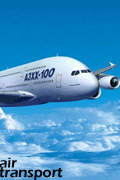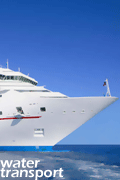Thursday, March 5, 2009
The movement of huge amounts of cargo, as well as passengers, between nations and within our Nation depends on workers in water transportation occupations, also known on commercial ships as merchant mariners. They operate and maintain deep-sea merchant ships, tugboats, towboats, ferries, dredges, offshore supply vessels, excursion vessels, and other waterborne craft on the oceans, the Great Lakes, rivers, canals, and other waterways, as well as in harbors. (Workers who operate watercraft used in commercial fishing are described in the section on fishers and fishing vessel operators elsewhere in the Handbook.)
Captains, mates, and pilots of water vessels command or supervise the operations of ships and water vessels, both within domestic waterways and on the deep sea. Captains or masters are in overall command of the operation of a vessel, and they supervise the work of all other officers and crew. Together with their department heads, captains ensure that proper procedures and safety practices are followed, check to make sure that machinery and equipment are in good working order, and oversee the loading and discharging of cargo or passengers. They also maintain logs and other records tracking the ships movements, efforts at controlling pollution, and cargo and passengers carried.
Deck officers or mates direct the routine operation of the vessel for the captain during the shifts when they are on watch. On smaller vessels, there may be only one mate (called a pilot on some inland towing vessels), who alternates watches with the captain. The mate would assume command of the ship if the captain became incapacitated. When more than one mate is necessary aboard a ship, they typically are designated chief mate or first mate, second mate, third mate, etc. Mates also supervise and coordinate activities of the crew aboard the ship. Captains and mates determine the course and speed of the vessel, maneuvering to avoid hazards and continuously monitoring the vessel's position with charts and navigational aides. Captains and mates oversee crew members who steer the vessel, determine its location, operate engines, communicate with other vessels, perform maintenance, handle lines, and operate equipment on the vessel. They inspect the cargo holds during loading to ensure that the load is stowed according to specifications and regulations. Captains and mates also supervise crew members engaged in maintenance and the primary upkeep of the vessel.
Pilots guide ships in and out of harbors, through straits, and on rivers and other confined waterways where a familiarity with local water depths, winds, tides, currents, and hazards such as reefs and shoals are of prime importance. Pilots on river and canal vessels usually are regular crew members, like mates. Harbor pilots are generally independent contractors who accompany vessels while they enter or leave port. Harbor pilots may pilot many ships in a single day.
Ship engineers operate, maintain, and repair propulsion engines, boilers, generators, pumps, and other machinery. Merchant marine vessels usually have four engineering officers: A chief engineer and a first, second, and third assistant engineer. Assistant engineers stand periodic watches, overseeing the safe operation of engines and machinery.
Marine oilers and more experienced qualified members of the engine department, or QMEDs, assist the engineers to maintain the vessel in proper running order in the engine spaces below decks. These workers lubricate gears, shafts, bearings, and other moving parts of engines and motors; read pressure and temperature gauges; record data; and sometimes assist with repairs and adjust machinery.
Sailors or deckhands operate the vessel and its deck equipment under the direction of the ship's officers and keep the nonengineering areas in good condition. They stand watch, looking out for other vessels and obstructions in the ship's path, as well as for navigational aids such as buoys and lighthouses. They also steer the ship, measure water depth in shallow water, and maintain and operate deck equipment such as lifeboats, anchors, and cargo-handling gear. On vessels handling liquid cargo, mariners designated as pumpmen hook up hoses, operate pumps, and clean tanks; on tugboats or tow vessels, they tie barges together into tow units, inspect them periodically, and disconnect them when the destination is reached. When docking or departing, they handle lines. They also perform routine maintenance chores, such as repairing lines, chipping rust, and painting and cleaning decks or other areas. Experienced sailors are designated able seamen on oceangoing vessels, but may be called simply deckhands on inland waters; larger vessels usually have a boatswain, or head seaman.
A typical deep-sea merchant ship has a captain, three deck officers or mates, a chief engineer and three assistant engineers, plus six or more seamen, such as able seamen, oilers, QMEDs, and a cook. The size and service of the ship determine the number of crewmembers for a particular voyage. Small vessels operating in harbors, on rivers, or along the coast may have a crew comprising only a captain and one deckhand. On smaller vessels the cooking responsibilities usually fall under the deckhands duties.
On larger coastal ships, the crew may include a captain, a mate or pilot, an engineer, and seven or eight seamen. Some ships may have special unlicensed positions for entry level apprentice trainees. Unlicensed positions on a large ship may include a full-time cook, an electrician, and machinery mechanics.
Motorboat operators operate small, motor-driven boats that carry six or fewer passengers on fishing charters. They also take depth soundings in turning basins and serve as liaisons between ships, between ship and shore, between harbors and beaches, or on area patrol.
Captains, mates, and pilots of water vessels command or supervise the operations of ships and water vessels, both within domestic waterways and on the deep sea. Captains or masters are in overall command of the operation of a vessel, and they supervise the work of all other officers and crew. Together with their department heads, captains ensure that proper procedures and safety practices are followed, check to make sure that machinery and equipment are in good working order, and oversee the loading and discharging of cargo or passengers. They also maintain logs and other records tracking the ships movements, efforts at controlling pollution, and cargo and passengers carried.
Deck officers or mates direct the routine operation of the vessel for the captain during the shifts when they are on watch. On smaller vessels, there may be only one mate (called a pilot on some inland towing vessels), who alternates watches with the captain. The mate would assume command of the ship if the captain became incapacitated. When more than one mate is necessary aboard a ship, they typically are designated chief mate or first mate, second mate, third mate, etc. Mates also supervise and coordinate activities of the crew aboard the ship. Captains and mates determine the course and speed of the vessel, maneuvering to avoid hazards and continuously monitoring the vessel's position with charts and navigational aides. Captains and mates oversee crew members who steer the vessel, determine its location, operate engines, communicate with other vessels, perform maintenance, handle lines, and operate equipment on the vessel. They inspect the cargo holds during loading to ensure that the load is stowed according to specifications and regulations. Captains and mates also supervise crew members engaged in maintenance and the primary upkeep of the vessel.
Pilots guide ships in and out of harbors, through straits, and on rivers and other confined waterways where a familiarity with local water depths, winds, tides, currents, and hazards such as reefs and shoals are of prime importance. Pilots on river and canal vessels usually are regular crew members, like mates. Harbor pilots are generally independent contractors who accompany vessels while they enter or leave port. Harbor pilots may pilot many ships in a single day.
Ship engineers operate, maintain, and repair propulsion engines, boilers, generators, pumps, and other machinery. Merchant marine vessels usually have four engineering officers: A chief engineer and a first, second, and third assistant engineer. Assistant engineers stand periodic watches, overseeing the safe operation of engines and machinery.
Marine oilers and more experienced qualified members of the engine department, or QMEDs, assist the engineers to maintain the vessel in proper running order in the engine spaces below decks. These workers lubricate gears, shafts, bearings, and other moving parts of engines and motors; read pressure and temperature gauges; record data; and sometimes assist with repairs and adjust machinery.
Sailors or deckhands operate the vessel and its deck equipment under the direction of the ship's officers and keep the nonengineering areas in good condition. They stand watch, looking out for other vessels and obstructions in the ship's path, as well as for navigational aids such as buoys and lighthouses. They also steer the ship, measure water depth in shallow water, and maintain and operate deck equipment such as lifeboats, anchors, and cargo-handling gear. On vessels handling liquid cargo, mariners designated as pumpmen hook up hoses, operate pumps, and clean tanks; on tugboats or tow vessels, they tie barges together into tow units, inspect them periodically, and disconnect them when the destination is reached. When docking or departing, they handle lines. They also perform routine maintenance chores, such as repairing lines, chipping rust, and painting and cleaning decks or other areas. Experienced sailors are designated able seamen on oceangoing vessels, but may be called simply deckhands on inland waters; larger vessels usually have a boatswain, or head seaman.
A typical deep-sea merchant ship has a captain, three deck officers or mates, a chief engineer and three assistant engineers, plus six or more seamen, such as able seamen, oilers, QMEDs, and a cook. The size and service of the ship determine the number of crewmembers for a particular voyage. Small vessels operating in harbors, on rivers, or along the coast may have a crew comprising only a captain and one deckhand. On smaller vessels the cooking responsibilities usually fall under the deckhands duties.
On larger coastal ships, the crew may include a captain, a mate or pilot, an engineer, and seven or eight seamen. Some ships may have special unlicensed positions for entry level apprentice trainees. Unlicensed positions on a large ship may include a full-time cook, an electrician, and machinery mechanics.
Motorboat operators operate small, motor-driven boats that carry six or fewer passengers on fishing charters. They also take depth soundings in turning basins and serve as liaisons between ships, between ship and shore, between harbors and beaches, or on area patrol.
posted by transport blogs
@ 8:58 PM
permanent link | Post a Comment
|
![]()









